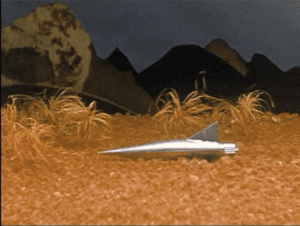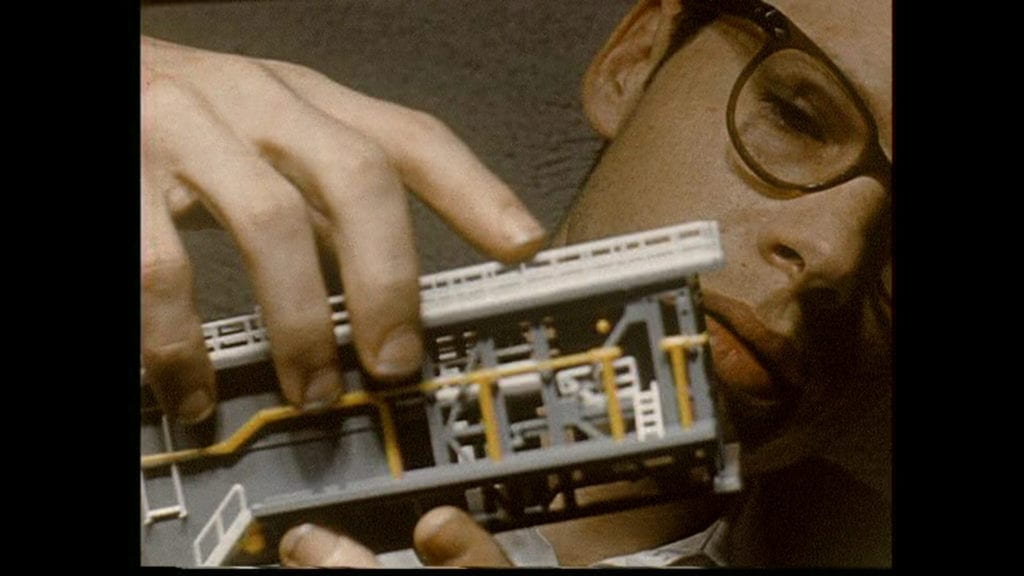Orphans in Space: Forgotten Films from the Final Frontier
special edition for Roger That! 2021
 Beyond the Moon (R. E. Barnes, ca. 1961)
Beyond the Moon (R. E. Barnes, ca. 1961)
11 min., color, silent
Narration by Megan Prelinger
Soundtrack by Agatha Kasprzyk and Rafaël Leloup (2011)
Source: Prelinger Archives
After a stint in the U.S. Navy, Robert Earl Barnes (1931-2009) spent most of his career at television station WKEF in Dayton, Ohio, where he was a satellite coordinator. He was also a prolific amateur filmmaker, often working in science fiction and horror genres.
For Beyond the Moon Barnes filmed miniatures, model kits, and tabletop sets, enacting the launch of a spacecraft that travels to Mars. Most objects move, slowly, on pulled wires, although Barnes also employs stop-motion cinematography. Efficient and simple, so-called tabletop animation was a favorite of amateurs. With a camera, lights, and a shutter-release mechanism, one could bring three-dimensional objects to life a frame at a time. So involved was Barnes’ production design that he simultaneously made a making-of documentary about his own making of Beyond the Moon, which he entitled Putting Tomorrow on the Table.
[archiveorg beyondthemoon width=640 height=480 frameborder=0 webkitallowfullscreen=true mozallowfullscreen=true]Given the time and places in which Barnes lived, his cinematic imagination’s inclination toward outer space makes sense. He experienced life in the Wright brothers’ hometown and the Cold War military, directed satellite communication, and shot films during the heyday of indelible science fiction movies. Narratives of space travel then ranged from A pictures, such as George Pal’s Destination Moon (1950) and MGM’s Forbidden Planet (1956), to a multitude of B movies like Project Moonbase and Cat-Women on the Moon (both 1953), to Ed Wood’s infamously nearly-amateur Plan 9 from Outer Space (1959). With its use of toys, the Barnes production also calls to mind an array of period juvenilia, including Gumby on the Moon (1956), Art Clokey’s claymation pilot for The Gumby Show (1957-68), which first aired on NBC’s kiddie series The Howdy Doody Show.
The period in which R. E. Barnes made Beyond the Moon corresponds to the era Megan Prelinger documents in her 2010 book Another Science Fiction: Advertising the Space Race, 1957-1962. There she illustrates the ubiquity of space travel and rocketry in the period’s visual culture, an iconography across fiction and nonfiction forms. Barnes himself sometimes inserted clips from popular movies, stock footage, and newsfilm into his work.
As research by Anderson and Hammer points out, Beyond the Moon is a conjunction of salient elements of postwar American leisure culture. The era’s do-it-yourself phenomenon encouraged both amateur filmmaking and plastic model building of the sort in which Barnes engaged. (Steven M. Gelber’s 1999 history, Hobbies: Leisure and the Culture of Work in America, found Americans at the time spent more on model kits than on any other hobby).

Two particular spacecraft Barnes assembled reveal his film as a pre-Apollo production. The Convair Atlas model rocket kit was manufactured in 1958, the first year of NASA’s Mercury program, which used Atlas rockets to launch men (and a chimp) into orbit. We also see a Strombecker brand model of Wernher von Braun’s wheel-shaped S-1 Space Station, marketed during 1955-58. This and other Strombecker kits were cross-promoted with the Disney movies Man in Space and Man and the Moon (both 1955), as well as Mars and Beyond (1957), all made as segments for the anthology television series Disneyland. Walt Disney himself introduced the episodes, displaying Strombecker models on his desk. (See fantastic-plastic.com, Allen B. Ury’s “virtual museum” of spacecraft kits.)
Making Beyond the Moon was not rocket science or Disney imagineering, but a guileless and playful piece of homespun, space-age cinema.
—
Seth Anderson, Caitlin Hammer, and Lorenzo Gattorna provided the research upon which Dan Streible based this essay. Their work was for Howard Besser’s NYU course Introduction to Moving Image Archiving and Preservation.
Preservation note
The unique unpreserved 16mm print of Beyond the Moon is on Kodachrome stock, transferred to DigiBeta videotape. In 2009, Rick Prelinger purchased it and Putting Tomorrow on the Table through an eBay auction. The seller obtained the films at an estate sale, along with many other Barnes prints. Thus, in less than a year they traveled a familiar route for amateur films orphaned upon the death of their maker: sold off in bulk to a disinterested party, a collection is subdivided and resold in pieces on eBay, where collectors vie with archives for acquisition.
